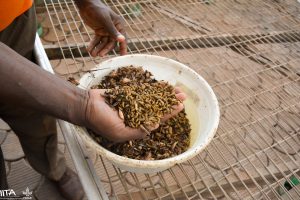DURHAM, North Carolina, May 31, 2024 (GLOBE NEWSWIRE) — Fortrea (Nasdaq: FTRE) (das „Unternehmen“), ein weltweit führendes Auftragsforschungsinstitut (Contract Research Organization, CRO), hat heute seine umfassende und integrierte Lösung zur Verbesserung der Diversität und Inklusion (D&I) von Teilnehmern an klinischen Studien bekanntgegeben. Die D&I–Lösung von Fortrea wurde entwickelt, um den Zugang von Patienten zur Teilnahme an klinischen Studien zu erweitern und die Anforderungen der U.S. Food and Drug Administration (FDA) gemäß dem Food and Drug Omnibus Reform Act zu erfüllen, um die Rekrutierung unterrepräsentierter Bevölkerungsgruppen in klinischen Studien zu erhöhen.
Der umfassende Prozess von Fortrea umfasst fünf Komponenten der Planung und Durchführung von Maßnahmen in Bezug auf Diversität:
- Die Berater recherchieren relevante Daten aus der realen Welt, um die Diversitätsplanung zu unterstützen.
- Experten aus den Bereichen Regulierung, Entwicklung und klinischer Betrieb entwerfen den Aktionsplan zur Förderung der Vielfalt, stimmen ihn mit Patientengruppen ab und verhandeln mit den Regulierungsbehörden.
- Die operativen Teams greifen auf mehrere Datenplattformen, das Site Advisory Board von Fortrea und technologiegestützte Lösungen zu, um den Diversitäts–Aktionsplan als integralen Bestandteil der Durchführung klinischer Studien bei Fortrea umzusetzen.
- Überwachung und Berichterstattung werden durch das exklusive Diversity and Inclusion Study Insights Dashboard von Fortrea ermöglicht, das umsetzbare Daten und Visualisierungen für das laufende Studienmanagement liefert.
- Erfahrene technische Redakteure stellen Daten zusammen und bereiten Berichte für die Einreichung bei den Aufsichtsbehörden vor, wobei im Rahmen der D&I–Lösung fortlaufend Unterstützung bei der Regulierung geleistet wird.
„Klinische Forschung, die eine repräsentative Population widerspiegelt, gibt einen besseren Einblick in die Wirkungsweise einer potenziellen Behandlung in einem realen Umfeld“, so John Doyle, DrPH, President von Fortrea Consulting. „Die jüngsten behördlichen Anforderungen kodifizieren die Fortschritte, die die Biopharmaziebranche in den letzten Jahren bei der Verbesserung der Einbeziehung verschiedener Bevölkerungsgruppen in ihre Entwicklungsprogramme gemacht hat. Die Lösung von Fortrea bietet tiefgreifende, praxisnahe Datenexpertise, um D&I–Pläne zu entwerfen, die effektiv und realistisch sind, zusammen mit mehr als 30 Jahren Erfahrung in der Durchführung von Studien in mehr als 20 therapeutischen Bereichen. Wir engagieren uns auch konsequent für D&I, nicht nur in klinischen Studien, sondern in unserem gesamten Unternehmen, da wir unser Ziel verfolgen, Patienten schneller lebensverändernde Therapien zur Verfügung zu stellen.“
Die D&I–Lösung von Fortrea umfasst eine Reihe von proprietären Tools, darunter epidemiologische und Machbarkeitsanalysen, die eine exklusive Kombination großer Datensätze nutzen. Die Lösung integriert auch Eingaben von Patientengruppen, um Einblicke in die Protokolltoleranz und die Anforderungen an die Unterstützung der Studiendurchführung bei unterschiedlichen Patientengruppen in verschiedenen Therapiebereichen und Regionen zu erhalten. Diese Erkenntnisse bilden die Grundlage für globale und lokale Pläne zur Patientenrekrutierung und –bindung, um unterrepräsentierte Patientengruppen zu erreichen und Hindernisse für die Teilnahme an klinischen Studien zu beseitigen.
„Um die Einbeziehung verschiedener Patientengruppen in klinische Studien zu gewährleisten, bedarf es mehr als nur eines Plans, es bedarf der Einsicht und des Handelns“, so Mark Morais, Chief Operating Officer von Fortrea. „Aufgrund unseres umfassenden „Voice of Patient“–Programms und unserer Zusammenarbeit mit verschiedenen Prüfzentren und Prüfzentrumsnetzwerken wissen wir sehr genau, was nötig ist, um erfolgreich Bevölkerungsgruppen zu erreichen, die in klinischen Studien traditionell unterrepräsentiert sind. Bei Fortrea stützen wir uns auf Daten aus der Praxis, nutzen innovative Technologien und lassen uns von unserer Leidenschaft leiten, neue Therapien für alle Patienten zu entwickeln.“
Bitte besuchen Sie Diversität und Inklusion in klinischen Studien auf Fortrea.com für weitere Informationen.
Über Fortrea
Fortrea (Nasdaq: FTRE) ist ein weltweit führender Anbieter von Lösungen für die klinische Entwicklung und den Zugang zu Patienten in der Biowissenschaftsbranche. Wir arbeiten mit aufstrebenden und großen biopharmazeutischen, biotechnologischen, medizintechnischen und diagnostischen Unternehmen zusammen, um Innovationen im Gesundheitswesen voranzutreiben, die das Angebot lebensverändernder Therapien für Patienten beschleunigen. Fortrea bietet Management von klinischen Studien der Phasen I–IV, klinische Pharmakologie, Beratungsdienstleistungen, differenzierte technologiegestützte Studienlösungen und Dienstleistungen nach der Zulassung.
Die Lösungen von Fortrea basieren auf drei Jahrzehnten Erfahrung in mehr als 20 Therapiegebieten, einer Leidenschaft für wissenschaftliche Strenge, außergewöhnlichen Erkenntnissen und einem starken Netzwerk von Prüfzentren. Unser talentiertes und vielseitiges Team in über 90 Ländern ist so skaliert, dass wir unseren Kunden weltweit gezielte und flexible Lösungen anbieten können.
Erfahren Sie unter Fortrea.com mehr darüber, wie Fortrea zu einer transformativen Kraft von der Pipeline bis zum Patienten wird, und folgen Sie uns auf LinkedIn und X (früher Twitter) @Fortrea.
Kontakt zu Fortrea:
Fortrea – Medien: Galen Wilson – 703–298–0802, media@fortrea.com
Fortrea – Medien: Kate Dillon – 646–818–9115, kdillon@prosek.com

GLOBENEWSWIRE (Distribution ID 9146941)




